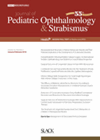
Journal Reviews
Horizontal recti injection of botulinum toxin for treatment of infantile nystagmus
In this study the authors aimed to demonstrate the effect of botulinum toxin (BT) on the frequency of ocular oscillation in children with infantile nystagmus syndrome (INS). Botulinum toxin was administered with direct injection into the horizontal recti muscles using...
Risks for ROP development in mid and late preterm infants
The authors evaluated the incidence, risk factors and retinopathy of prematurity (ROP) development in mid and late preterm infants born at 32 to <37 weeks of gestational age (GA). This was a retrospective study of 5477 infants: 54.4% male. Overall,...
Risks of advanced ROP development in unscreened babies
The authors report a retrospective study of the prevalence of infants with stage 4b and 5 retinopathy of prematurity (ROP) who were never screened and the importance of screening guidelines. The study was conducted in a tertiary eye hospital in...
Comparison of surgical options for basic intermittent exotropia
This study compared the outcomes of three surgical options from one surgeon, to treat basic intermittent exotropia. Surgeries included bilateral lateral rectus recession (BLR), unilateral lateral / medial rectus recession / resection (RR), and unilateral lateral rectus recession and medial...
Long-term outcomes of using intraoperative relaxed muscle positioning technique in thyroid eye disease
The authors present a retrospective case review of consecutive patients undergoing ocular muscle surgery by one ophthalmologist using the intraoperative relaxed muscle positioning (IRMP) technique for thyroid eye disease (TED)-associated strabismus over a 23-year period. The following data were extracted...
Macular choroidal changes after inferior oblique muscle surgery
This study was undertaken to investigate the retinal neurovasculature, choroidal thickness and choroidal vascular index (CVI) changes at the macula at one week, one- and three-month intervals post inferior oblique muscle myectomy. The hypothesis was that, given the close proximity...
BT vs primary surgery for infantile esotropia
In this study, the success rate of treatment for infantile esotropia (IET) patients who had surgery because of under correction after botulinum toxin (BT) is compared to those having primary surgery. The study included 52 patients (27 male) with mean...
Differences in strabismus surgery outcomes in preterm vs full-time birth infants
This study aimed to analyse motor and sensory outcomes of strabismus surgery in 70 preterm (group 1) and 242 full-term (group 2) infants. Group 1 mean gestational age and birth weight were 31.25 ±2.51 weeks and 1562.70 ±412.82g. Pre and...
Barriers to diagnosis and management of VKC
The authors investigate the lived experience of vernal keratoconjunctivitis (VKC) diagnosis and treatment in US patients, reported by their carers and eyecare clinicians, and to identify barriers to the timely diagnosis and management of this condition. The study included seven...
Sensory and motor function changes after surgery for epiblepharon
In this study the authors investigate the effect of epiblepharon (EB) correction on motor and sensory function in children with EB and comorbid strabismus. Ninety eyes of 45 children were evaluated: mean age 6.8 ±2.9 years, 18 males, 27 females,...
Re-evaluation of virtual reality visual field testing
This study evaluated an updated testing algorithm to determine its dynamic range, and to assess if this produced a suitable central hill of vision, and to evaluate test-retest reproducibility in healthy children. This was a prospective study of children with...
Vigabatrin-induced retinal toxicity detected by 30Hz ERG
The purpose of this study was to assess the role of 30Hz flicker electroretinogram (ERG) as a marker for measuring changes in visual function over time in children receiving vigabatrin. This was an observational study of 11 children with mean...






